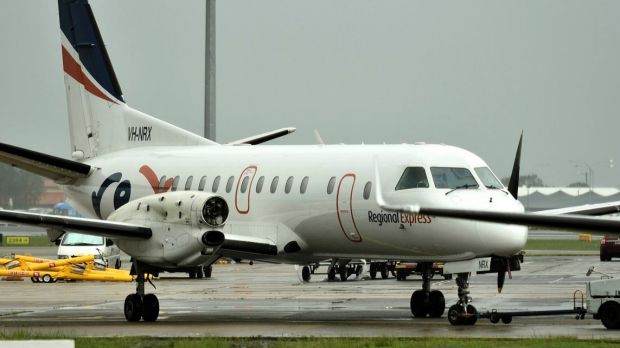Popular
Passenger plane’s propeller shears off in mid-flight, forcing emergency landing in Australia

Passengers and crew on a Regional Express aircraft flying from Albury in NSW have made a lucky escape after one of its propellers sheared off in mid-flight, narrowly avoiding hitting the wing and tail and forcing its pilots to make an emergency landing at Sydney Airport.Three Saab 340, carrying 16 passengers and three crew, was about 10 nautical miles from Sydney Airport when its right-hand propeller flew off, leading the two pilots to declare a PAN, which is one step down from a full-scale Mayday.
The pilots are understood to have felt a vibration and were about to shut down the right-hand engine when they looked out the cockpit window to see the propeller – rotating at thousands of revolutions per minute – disappear over the plane’s wing.
Following the PAN call to air-traffic control, emergency services readied for the 34-seat plane’s arrival at the airport, but it landed safely shortly after midday on Friday.
Aviation watchers say it was “incredibly lucky” the propeller did not hit the wing, fuselage or the tail, which could have been catastrophic for the aircraft and those on board.
“They were a hair’s breadth away from a disaster. I don’t know how the hell it didn’t damage the aircraft as it went past,” Australian Licensed Aircraft Engineers Association president Paul Cousin said.
“There would be no reason for [those pilots] to take a Tatts Lotto because [they] have have used all of their luck getting out of that situation.”
Mr. Cousins said the pilots had demonstrated skill in overcoming the initial shock of the propeller disappearing before their eyes and then gliding the plane in safely to land at Sydney Airport.
Courtesy : The Sydney morning herald

Asia
Singapore Airlines emergency landing after severe turbulence

One passenger passed on, while dozens of passengers were injured when a Singapore Airlines Boeing B777-300ER aircraft experienced severe turbulence while en route to Singapore from London Heathrow Airport. The aircraft diverted to Bangkok, and landed at 3:45pm Local time on 21 May 2024
The flight landed with 211 Passengers and 11 Crew members at Bangkok Suvarnabhumi Airport. According to the Airport Director Kittipong Kittikachorn at a news conference, there were 7 passengers who suffered serious injuries, while a number of other passengers suffered injuries of varying seriousness.
It was also confirmed that the passenger who passed on was a 73 year old British Man. In a statement from Singapore Airlines ‘ As of 0505 hours Singapore Time on 22 May 2024, 79 passengers and 6 crew members from SQ321 remain in Bangkok’. In another statement, it was reported that a relief flight with 143 passengers and crew members arrived in Singapore at 0505 hours Singapore time on 22 May 2024.
According to aircraft tracking site FlightRadar24, the 16 Year Old Boeing B777-300ER aircraft descended sharply from 37,000 feet to 31,000 feet in a short time. It was also further reported by FlightRadar24 that the descent was commanded by Autopilot, instead of being caused by turbulence.
Shortly afterwards, the pilot declared an emergency by squeaking 7700 on the transponder, indicating an emergency situation onboard the aircraft. The Boeing 777 aircraft then diverted to Bangkok, instead of continuing on its planned journey to Singapore.
In view of this incident, Singapore Airlines mentioned in a statement that they are working with the relevant authorities on the investigation into this incident.
The National Transportation Safety Board, a US Government investigative agency for civil aviation incidents, is sending an accredited representative and 4 technical advisors to support the investigation by Singapore’s Transport Safety Investigation Bureau (TSIB). TSIB mentioned in a statement that it ‘is in touch with its Thai counterparts and will be deploying investigators to Bangkok’.
Boeing, the manufacturer of the Boeing B777 aircraft mentioned in a statement that they are in contact with Singapore Airlines regarding the ill-fated flight, and ‘stand ready to support them’.
This situation is developing, more details will be added when they become available.
-

 Travel1 week ago
Travel1 week agoAir India to Expand US Operations with Three New Routes After a Decade
-

 Travel2 weeks ago
Travel2 weeks agoWhy We Should Avoid These Stamps in a Passport
-

 Airlines1 month ago
Airlines1 month agoInvestigations Reveal Fake Chinese Titanium in Boeing and Airbus Jets
-

 Tech4 weeks ago
Tech4 weeks agoChina’s CATL Plans 1,800-Mile Electric Plane Launch by 2027
-

 Airport3 days ago
Airport3 days agoTop 10 Largest Airports in the World by Size
-

 Aerospace4 weeks ago
Aerospace4 weeks agoChina’s Fighter Jets Turn Wings into Autonomous Drones
-

 Airlines4 days ago
Airlines4 days agoAir India Rolls Out A350s for Delhi-New York JFK and Newark Routes
-

 Defence3 weeks ago
Defence3 weeks agoBoeing Enhances Chinook with New Engines and Block II Upgrades at $96 Million







